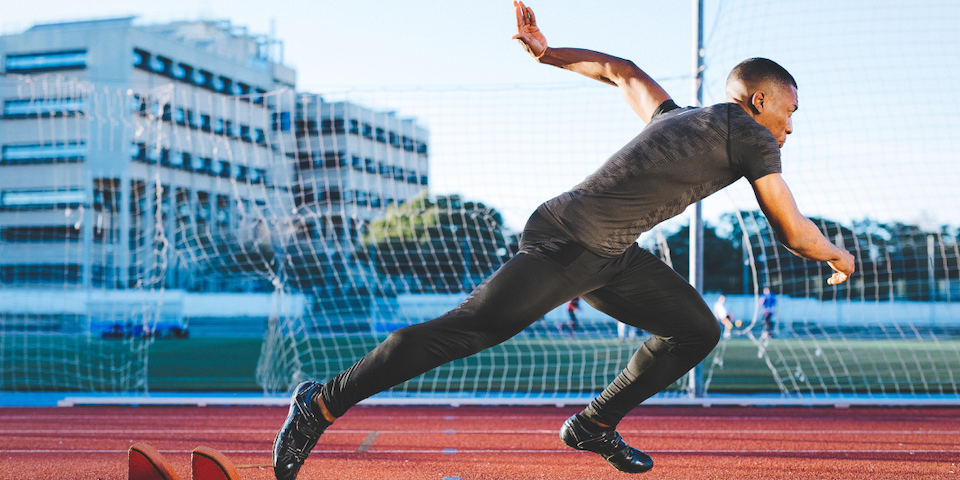When was the last time you really had to sprint? Heart pumping, legs burning, and you’re going as fast as you can?
If you can’t remember, you’re missing out on one of the best tools for challenging your body and improving body composition. Sprinting is arguably one of the most essential training tools for athletic performance.
If you’re going to work sprints into your routine, you need to consider the best ways to approach them to maximize their use and protect yourself. When you do, you will see your body’s performance improve.
What are the benefits of sprinting?

Enhances athletic performance
Sprinting carries over into every sport because of the strength, power and speed advantages. “Because it’s so explosive, it’s activating virtually every muscle in the human body,” says Mike Young, Ph.DDirector of the Athletic Lab, which focuses on speed development and athletic performance. “Not much else in the fitness world works every muscle group as aggressively as you see in sprinting,” Young says.
Improves body composition
Beyond athletic performance, the benefits of sprinting extend to the body’s physical qualities, Yang said.
“You benefit from higher intensity through body composition and fat mass—more athletic glutes, hamstrings, and quads,” he says. “That’s why you see elite sprinters look the way they do — really lean and muscular. Some of that comes from sprinting.”
How to Adapt Your Body to Sprinting
Sprinting is an intense, high-impact exercise. To protect your body and get the most out of your sprints, follow these tips
warm up
When you start sprinting, start with a quick warm-up like high knees and lunges to loosen up your body and prime it for the sprint. Then start the basic movement, letting your tissues, muscles and even bones adapt to the intensity, says Rooney. Even sprinting in place can be a good starting point as your body gets used to the movement.
“You have to awaken the nervous system that accesses the large muscle fibers — the large motors. When you do that, you can work that muscle,” says Rooney.
Start slow
If the last time you sprinted was in high school gym class, don’t go straight out and do the 100-yard dash. You just want to start moving faster again, say Martin Rooney, CSCSFounder of Warrior Training.
This can be a quick step up a speed ladder or a slightly faster pace than feels comfortable. While there’s no “perfect” distance to sprint, aim for 30 yards or more when you’re first starting out.
Maintain your body
You should work on mobility — through stretches and dynamic movements like lunges that improve your range of motion — so you lower your risk of injury.
And if you’re overweight than you should be, dialing back your nutrition and losing weight will improve your ability to sprint, Rooney says.
4 Sprinting Tips to Get You Faster
If you want to make sure you’re enjoying all the benefits of sprinting, here are four tips to help you do it right.
1. Keep your mechanics tight

The fastest body is the most efficient body, meaning you’re not wasting energy misplacing body parts. While it may seem like running fast is, well, running fast, you’re not maximizing your effort.
Your Physiological Checklist for Great Sprinting Technique:
- Lean your whole body forward. Instead of just arching your back, Young suggests leaning up from your ankles so your head, neck, spine and pelvis are all aligned.
- Fix your head. “A common error is the head rotating out of normal postural alignment,” says Young. That means energy transfer from the ground is not transferred efficiently throughout the body. Since the human body isn’t ideally designed for sprinting (we’re very vertical compared to a cheetah’s horizontal position), a wobbly head makes an inefficient system even more so.
2. Accelerate with long strides
Good sprinting form is about how you accelerate through the run. “The physics of running haven’t changed: If you run in a world governed by physics, you can’t reach top speed without acceleration,” Young said.
This means your first steps are big, long steps — not the short, choppy ones you see some people take — with big, swinging arms. When you take short steps, you don’t generate a lot of power, because there is less contact time with the ground.
Longer stride length means longer contact time with the ground — and more power to propel the body forward, Young says.
3. Experiment with intensity
When most people hear the word “sprint,” they think “all-out.” Rooney said, this is not supposed to happen. You can aim for 70 or 80 percent of maximum effort in your workouts — and play around with different combinations of distances and intensities.
“When we say sprint, it doesn’t mean it has to be like a tiger chasing you,” Rooney said.
4. Strengthen your sprint muscles

The glutes and hamstrings — and all the muscles in your posterior chain — act as your engine for motion, Young says. Deadlifts, Romanian deadlifts, glute-ham raises and step-ups are great for strengthening those muscles to help with sprinting performance. Any single-leg exercise will also be helpful, Young says.
And there are few movements that train strength and speed better than plyometrics, which help build explosiveness.





